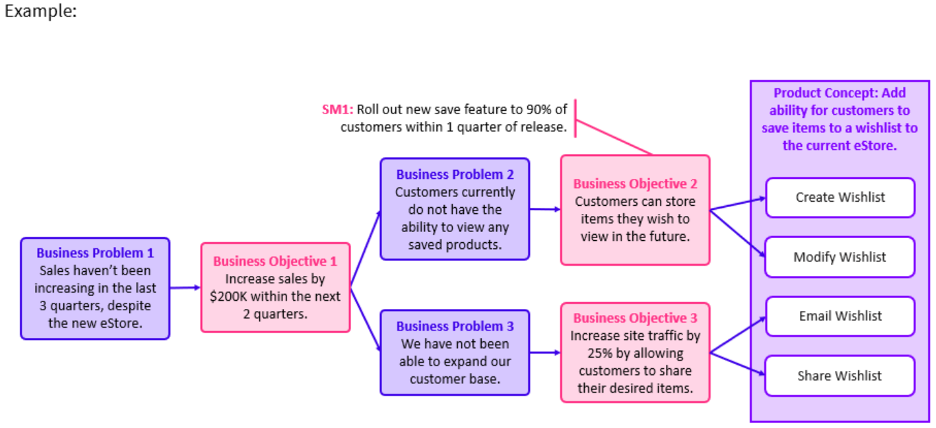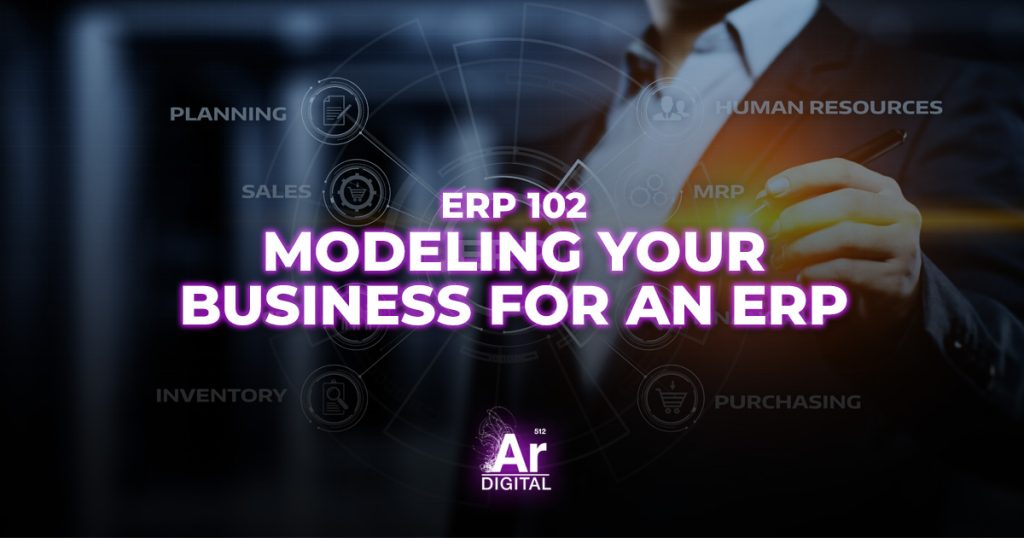How to Model Your Business in Preparation for an ERP
ERP systems are large and can be very complex. Modeling internal systems and business needs can help drill down to the key features that will provide the most value. Once the most valuable features are found, an agile approach to implementing an ERP system can yield the most benefit.
How to Detail Business Considerations
If you don’t know about the use cases of an ERP system, I recommend you read our first article on “ERP 101 – Which ERP is Best for Your Business?”
It is necessary to think about your organization’s internal operating structures, strategic growth, and efficiency before adding any kind of resource planning software.
For enterprise-level institutions (think Apple or Microsoft), teams of Product Managers, Directors, and consulting firms work daily to define and redefine structure, growth, and efficiency. For small and medium-sized companies, the following structure should help save time and money to help implement the best solution available.
It All Starts with Visual Models
At the heart of modeling is addressing the 5 W’s: Who, What, Where, When, and Why… and sometimes How, but we’ll save that for later.
As with any large problem, the first step is to list all the knowns and unknowns. Using models helps to detail all of the 5 W’s in a concise and actionable approach.
Let's Start with WHY...
If there is no need for new software, why devote time and money towards solving a problem that doesn’t exist? The Business Objectives Model (BOM) illustrates the why.
Understanding the Business Objective Model (BOM)
What is it?
A BOM links business problems with stated business objectives to help frame a solution that addresses the core business problem.
NOTE: A “business problem” must be aligned with the business and its purpose.
Why is it Important?
In a word, Alignment.
Building this model is hard. It’s an iterative process and requires moving forward and backward repeatedly while having an open conversation around questions like, “what’s stopping us from achieving this objective” and “if we did this/these step(s), would our problem be resolved?” While these questions seem simple enough, it’s not uncommon to have a few drafts that change wildly with each iteration. Once the “why” is answered, there will be a noticeably clear image of what you are looking to do, and exactly WHY you are doing it.
A BOM is extremely valuable for a team and any partner vendors because it ensures everyone understands and is aligned with the purpose of the endeavor. At the same time, this model will you to develop KPIs to track how an ERP (or any system being implemented) is performing to solve the identified business problem.

Now, Let's Talk About WHO is Involved
An ERP integrates many departments, so there will undoubtedly be several key people involved. Determining who the key decision makers are will shape the implementation of your ERP project. An Organizational Chart helps visualize who all needs to be involved.
Understanding the Organization Chart
What is it?
An Organizational Chart is a visualization of the people involved in the business, organized into an hierarchy that best supports the business objectives.
Why is it Important?
Having an organizational chart early on is critical, and it will gain importance throughout the process of implementation. Before decisions are made that affect the business there should be a clear understanding of who will be impacted, and who needs to be involved in the discussion/analysis/decision-making.
Much like the BOM, the importance of alignment between the business strategy and an ERP solution involves buy-in from all parties. A solution must be supported by the business structure, including, if necessary, reorganizing how people and departments are structured. These changes can be small or very large, but identifying how individuals interact early on can open discussion for what is truly needed to support the solution.

Next, WHAT is Involved?
An ERP is a complicated integration of multiple business operations. What business systems are needed to work together for the company to perform better? This is where an Ecosystem Map comes into play.
Understanding an Ecosystem Map
What is it?
An ecosystem map is a diagram of all the applications used to support the business. This map can be organized to highlight different business functions utilized by each application, both internally and externally.
Why is it Important?
The importance of an ecosystem map is the quick access to see the ‘connectedness’ of applications. If a change is being made to one system, this model helps visualize the repercussions or changes that must be made to all other systems involved. Additionally, when combined with the organizational chart discussed above, both systems and people can be linked to fully understand the changes needed in infrastructure for a successful ERP implementation.

WHEN is Each Part of an ERP Deployed?
Does the order in which parts of an ERP system deploy impact the overall operations of your business? The timing of implementation plays a critical role in any integration project, which is why it’s imperative to prepare a Feature Tree.
Understanding the Feature Tree
What is it?
A feature tree is a relational model that visualizes the features of a solution. This model organizes them into an hierarchy to identify subordinate and/or supporting features.
NOTE: A feature is a specific piece of functionality that has a corresponding benefit or set of benefits for the user.
Why is it Important?
A feature tree provides a strong visual to discuss features and identify where and when they are needed. It also provides a platform to quantify the value of given features with others. This is extremely helpful in the prioritization of the features and is used as one of the measures to evaluate when certain features should be implemented. As will be mentioned below, this model is vital for the agile development of ERPs within an organization.

WHERE is it Working?
Searching for where systems and people interact is the largest risk component. A Business Data Diagram illustrates the where these interactions occur.
Understanding the Business Data Diagram
What is it?
A Business Data Diagram is a relationship model that connects business data with business objects and shows cardinality (or quantity) between them.
Why is it Important?
A business data diagram should be based on objects relevant to the business, not “objects” as defined by the particular software being used. This is a model that can be created by someone familiar with the business because the goal is to show where information flows.
This model is critical because it gives you an understanding of many aspects of workflows simultaneously. Very quickly, the complexity of the business, and by extension, the amount of risk (where) that comes with changes to systems owning/managing these objects is detailed.

Features of ERPs and Their Size
Once the each of the above models are built, then the real fun begins! Given the number of companies that offer ERP software, looking at what solutions are available can be overwhelming.
Building these models further defines the requirements outlined in the first article (ERP 101 – Which ERP is Best for Your Business) that drills down on the actual needs of the business. Taking a methodical approach to software evaluation and implementation can significantly reduce pressures on management and result in a better operational fit.
Weighing Features of an ERP
Using the BOM and Feature tree models, it’s time to assign weight to which features are the most important. Not all of the wants and needs of the company will provide equal value. Before deciding what is important, making a sliding scale (i.e. 0 = no value, 3 = medium value, 5 = high value) helps to objectively evaluate where each feature falls within the scale of importance.
How to Know What's Important
BOMs and Feature Trees are only helpful for those who know what to do with them. While every business is uniquely different, certain features are pervasive across all organizations and tend to be industry agnostic. These are typical features for ERPs that should be given a higher weighting:
- Ease of integration into pre-existing software
- Compatibility with current business data that is critical for operations
- Ease of adding new functionality over time (both internally or externally with vendors)
- System Application health monitoring (Software can get sick sometimes – it’s good to have a pulse on how it’s functioning)
- System management tools (Admin)
- User management tools (Admin)
- Security (Both for company data and user data)
Building the framework models and answering these questions will give any company looking to implement a new or upgraded ERP system the best chance to properly align suitable options with their business needs.
Additionally, once the features have been ranked, an agile approach to implementation can be considered. Knowing the priorities of the business means that quick and actionable steps can be taken to make small changes that will have a large impact.
What Does All This Mean Relative to Modeling Your Business for an ERP?
Adding a comprehensive, and often large, software solution for operations at one time may not be in the cards, but updating one system at a time could both be doable and provide a lower barrier for buy-in from stakeholders.
Where Do You Go From Here?
Schedule a conversation with one of our Account Managers to get a better feel for the best approach to selecting the ERP right software to support your specific business goals. In the event you don’t already have a technology roadmap in place, we will likely recommend starting there to help plan your tech stack to ensure you’re investing in the right solutions at the right time and NOT wasting time or money trying to deploy solutions that don’t fit your business objectives.



